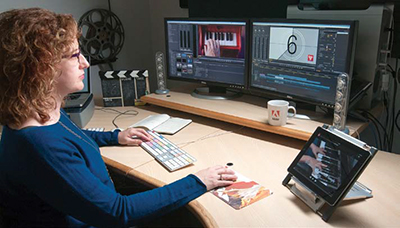CNN Adopts Adobe Anywhere
CNN announced recently that it has adopted Adobe Systems’ new collaborative workflow platform, Adobe Anywhere, as the central key to upgrading its entire international newsroom journalism editing and distribution approach. This could foretell a major paradigm shift in the way multicentric production and delivery systems will be shaped.

The Adobe Anywhere workflow Adobe revealed its Adobe Anywhere concept as a technology preview in 2012 and formally premiered it at the 2013 NAB Show. Now that CNN has come forward as a major adopter of the system, Adobe Anywhere has become a practical reality, and this column was the first publication they spoke to in detail about it.
REPLACING CREATIVE SUITE
“Adobe Anywhere is a collaboration platform that ties together Adobe’s creative applications with the customer’s own storage and asset management infrastructure,” said Michael Coleman, senior product manager for Adobe Anywhere at Adobe Systems. “It lets groups of editors and creative video folks work seamlessly together on the same application accessing the same media. Adobe Anywhere offers the benefits of shared media without actually moving ‘proxy’ files around because each participant is working with streaming versions from the original full resolution source material.”
Functioning as an enterprise-level system hosted in a private “cloud,” Adobe Anywhere works on-premise in a cluster of the customer’s own servers which enhances its security. It functions with Adobe’s two core components: the Adobe Anywhere Collaboration Hub containing all the project information and associated metadata; and the Adobe Mercury Streaming engine that enables dynamic real-time viewing of streams of source material complete with GPU-accelerated effects from Adobe Premiere Pro CC and sequences structured in Adobe Prelude CC.
You might take note of the “CC” behind each of those software components because Adobe Anywhere only functions with the new “Creative Cloud” versions of all of the company’s suite of digital tools, having included After Effects CC after the 2013 IBC Show. This replaces all the “Creative Suite” or “CS” editions of their digital creation classics including Adobe SpeedGrade, Audition, Media Encoder and Story. Creative Cloud software is no longer purchased as a standalone package, but is based on a renewable license model under which the user rents the latest version for the length of the subscription.
Currently, Adobe Anywhere cannot interface directly with non-Adobe production applications such as Final Cut Pro or Avid systems. But, as product manager Coleman said, “We’re open to that idea as soon as other companies want to work on it. It’s up to them.”
Adobe Anywhere came onto the market at the beginning of July 2013, and although specific numbers are not yet available, Coleman claims, “about 70 percent of our early adopting pilot customers have transitioned to purchase it.”
NETWORK INPUT
However, now CNN is not only glad to go public with their adoption of Adobe Anywhere version 1.6 in early August, but Michael Koetter, senior vice president of media technology and development at Turner Broadcasting, told me they were actually involved with its development by acting as a consultant on the project since 2011.
“Originally, our goal was to extend basic editing capabilities to the journalist’s desktop in production centers around the world from Moscow to London to L.A.,” Koetter said. “We worked with Adobe to enable their Premiere NLE to send the results of its Edit Decision Lists to our render farms in London, New York, Atlanta, and Washington D.C., all populated by Adobe Media Encoder software. That means that anything in our production system can go anywhere it is needed.”
In addition to providing journalists with low-res desktop clip sequencing capabilities, one of CNN’s top priorities is to begin migrating their approximately 700 higher end craft editing bays away from their worldwide standardizations on Apple’s Final Cut Pro 7 to using Adobe Premiere CC. Koetter was clear this will be a long-term process, and CNN is not turning off their FCP 7 integration right away. But Apple has announced they will not continue development of FCP 7 in the future.

Michael Koetter “Apple’s newer Final Cut X release did not have the capabilities we needed to execute a news-oriented workflow,” Koetter said, “so we went through a rigorous process with Adobe to vet Premiere for our needs and they responded with a very large number of modifications to their NLE, including features in their ‘editing finesse’ category and closed captioning tools. To us, Premiere appears to be the best-in-class craft editing system for our purposes.”
Of course, to optimize the new collaborative workflow of Adobe Anywhere they could not leave all that FCP 7 work behind.
“We have traditionally integrated with Final Cut Pro 7 using Final Cut XML interchange format for import/export,” Koetter said, “which for many people has become the new CMX EDL. But we found it is pretty low fidelity. The Final Cut XML we exchanged with Premiere in a journalist edit is just a little bit better than ‘mark-in/ mark-out’ for cuts only. We needed multilayer compositing, advanced effects such as motion blur, color correction and sophisticated titling. Final Cut handles this fine internally, but has problems communicating its ‘dark metadata’ to other systems to fully re-substantiate a complex edit. We needed something more robust for full Premiere integration.”
Koetter found that even Adobe’s own Premiere project files were never really designed as an edit interchange format, having no documented public open API. So CNN began consulting with Adobe to find a way of decoupling an editor into a client/ server ecosystem.
By working with the streaming video provided under the Adobe Anywhere concept, CNN encouraged a more powerful way to interact between their media management and workflow systems and the craft editing bays.
“This took away the brittle process of exchanging project files and got into the idea of having a server hold all our edit projects. So we worked with Adobe to make sure the API for that server can support everything we need to get into and out of an edit,” Koetter said. “Now journalists can create enhanced edit instructions to be sent to the craft bay, and collect other aspects like graphics elements which need to be included. With Adobe Anywhere, all of the intelligence that has been created with a project is immediately available to the finishing process without having to endlessly search through various storage levels. It’s all just right there.”
In the end, when I asked if the ultimate goal of this transition is to become “all Adobe.” Koetter replied, “that is correct.
“It’s a big lift to replace so many systems in our core editing environment,” he said, “ and we are trying to incorporate it in the natural replacement cycle for our infrastructure. With Adobe we’ve found a partnership that has opened many future possibilities for CNN.”
Jay Ankeney is a freelance editor and post-production consultant based in Los Angeles. Write him atjayankeney@mac.com.
Get the TV Tech Newsletter
The professional video industry's #1 source for news, trends and product and tech information. Sign up below.
